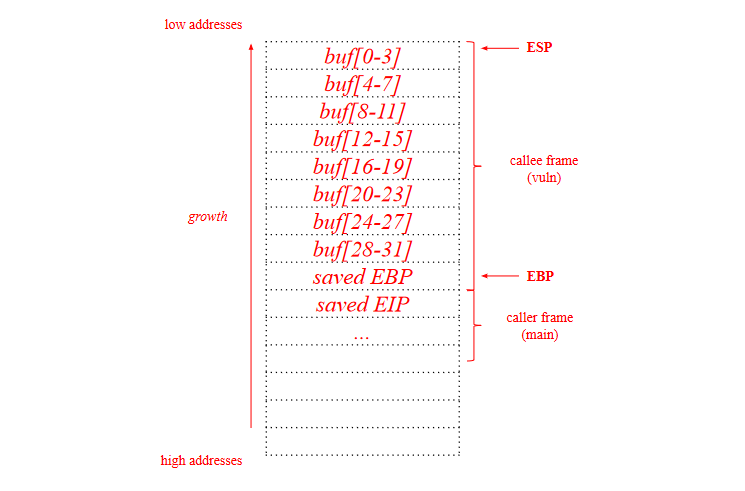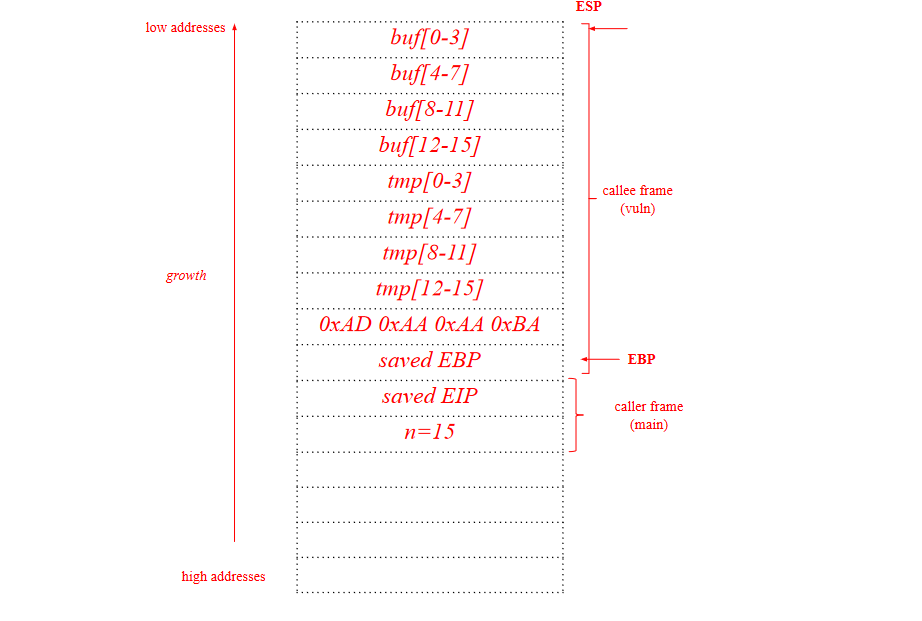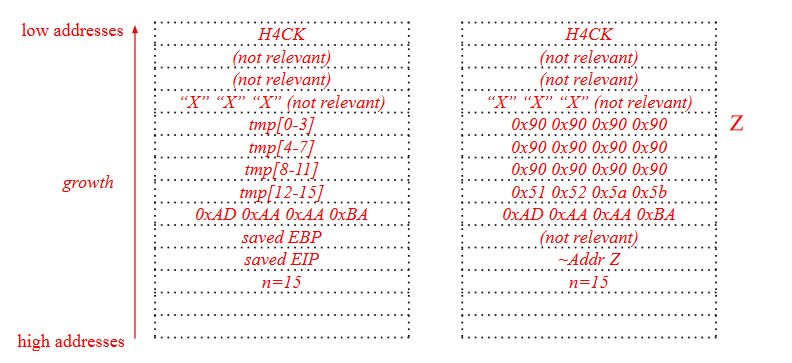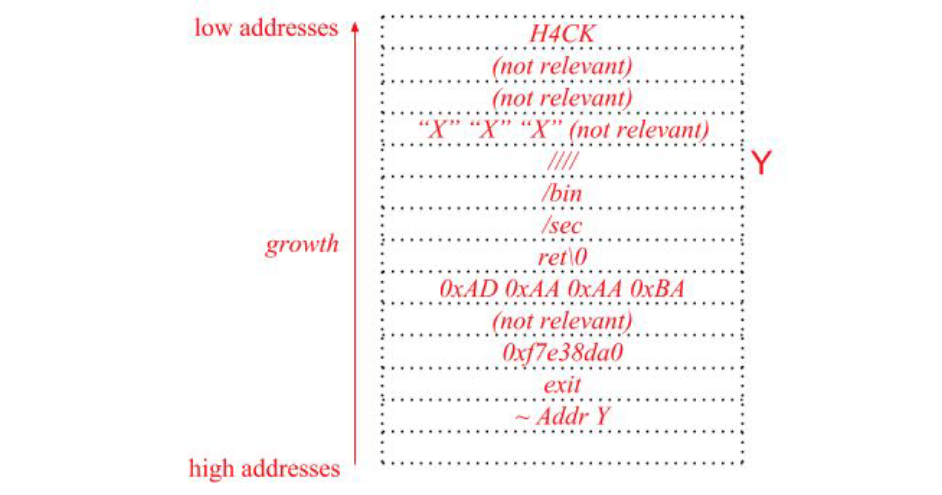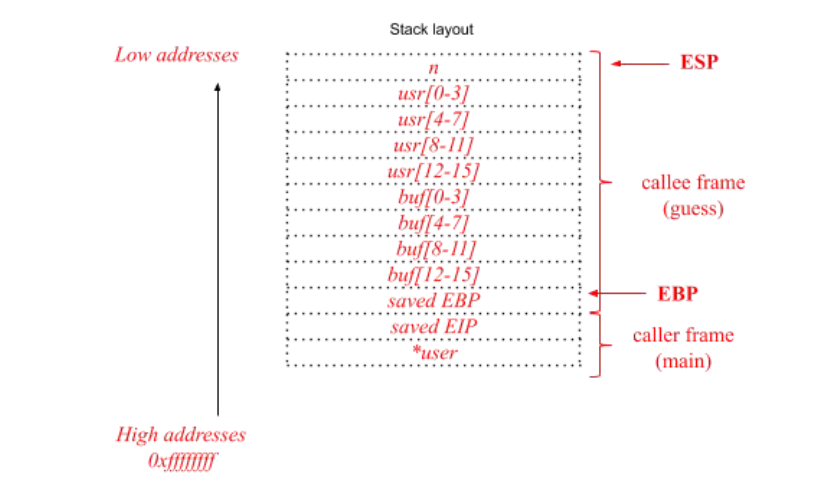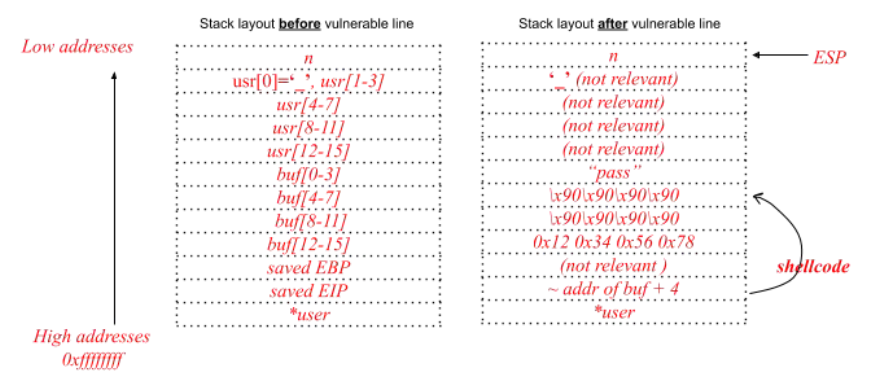Exercises on software security
2022-2021 DEMO Exam exercise 3 (6 points)
Assume that:
- The C standard library is loaded at a known address during every execution of the program, and that the address of the function
system()is0xf4d0e2d3. - Environment variables are located in the highest addresses.
- The program is compiled for the x86 architecture (32 bit) and for an environment that adopts the usual cdecl calling convention. Furthermore, assume that no compiler-level or OS-level mitigations against the exploitation of memory corruption errors are present (unless specified otherwise).
#include <stdio.h>
#include <stdlib.h>
#include <string.h>
#include <time.h>
typedef struct {
char base[8];
int r;
char buf[64];
char *str_p;
char canary[4];
} data_t;
void guess(int num, char *str, data_t *data) {
snprintf(data->buf, num, str);
if (strncmp(data->buf, "backdoor", 8) == 0){
scanf("%8s", data->str_p);
if (num == data->r){
system("/bin/sh\0");
}
}
if (strcmp(data->canary, "XXX") != 0)
abort();
}
int main(int argc, char** argv) {
int num;
data_t data;
srand(time(NULL));
num = atoi(argv[1]);
data.r = rand();
strcpy(data.canary, "XXX");
data.str_p = data.base;
guess(atoi(argv[1]), argv[2], &data);
}
- [1 point] The program is affected by typical buffer overflow and format string vulnerabilities. Complete the following table, focusing on a vulnerability per row.
| Vulnerability | Line | Modify the line to solve the detected vulnerability |
|---|---|---|
| Buffer Overflow | ||
| Format String |
-
[2 points] 2. Focus only on the stack-based buffer overflow(s) you found. Write an exploit for this vulnerability that must execute the following shellcode, composed of 16 bytes, which opens a shell:
0x20 0x30 0x40 0x50 0x60 0x70 0x80 0x90.- Describe all the steps and assumptions required for the successful exploitation of the vulnerability. Include also any assumption on how you must call the program (e.g., the values for the command-line arguments required to trigger the exploit correctly and/or environment variables, if any).
- Make sure that you show how the exploit will appear in the process memory with respect to the stack layout right before and after the execution of the vulnerable line during the program exploitation showing:
- Direction of growth and high-low addresses;
- The name of each allocated variable;
- The content of relevant registers (i.e., EBP, ESP);
- The functions stack frames.
- Show also the content of the caller frame.
-
[2 points] Focus only on the format string vulnerability you found. Assume that you were able to find this working exploit to execute a piece of shellcode saved in an environment variable.
\xb6\x06\x3a\x44\xb8\x06\x3a\x44%26543c%4$hn%9529c%5$hn. Clearly detail all the components of the format string exploit:- The decimal components of the address of the environment variable containing your shellcode (i.e., what to write)
- The address of the saved return address (i.e., the address where we want to write)
- The displacement on the stack of your format string.
-
[1 point] Consider ONLY the “Non-executable stack (NX)” mitigation technique. A friend of yours suggests that there is an alternative way to exploit the vulnerability/ies you found to spawn a privileged shell in the program without executing any shellcode or calling library functions. If it is possible, please explain all the steps and assumptions required for a successful exploitation of the vulnerabilities detected. Focus on one vulnerability at a time. Include also any assumption on how you must call the program (e.g., the values for the command-line arguments required to trigger the exploit correctly and/or environment variables, if any). If it is not effective, please explain why.
Question 1
Consider the C program below, which is affected by a typical buffer overflow vulnerability.
#include <stdio.h>
#include <stdlib.h>
#include <string.h>
void vuln() {
char buf[32];
/* <---------------- here */
scanf("%s", buf);
if (strncmp(buf, "Knight_King!", 12) != 0) {
abort();
}
}
int main(int argc, char** argv) {
vuln();
}
Assume that the program runs on the usual IA-32 architecture (32-bits), with the usual “cdecl” calling convention. Also assume that the program is compiled without any mitigation against exploitation (ASLR is off, stack is executable, and stack canary is not present).
Draw the stack layout when the program is executing the instruction at line 7, showing:
- Direction of growth and high-low addresses.
- The name of each allocated variable.
- The boundaries of frame of the function frames (main and vuln).
Show also the content of the caller frame (you can ignore the environment variables, just focus on what matters for the vulnerability and its exploitation).
Write an exploit for the buffer overflow vulnerability in the above program. Your
exploit should execute the following simple shellcode, composed only by 4
instructions (4 bytes): 0x12 0x34 0x56 0x78.
Write clearly all the steps and assumptions you need for the exploitation, and
show the stack layout right after the execution of the scanf() during the program
exploitation.
Solution
The function must return, this is the reason why buf must start with "Knight_King!". A is ESP + 3*4.
If address space layout randomization (ASLR) is active, is the exploit you just wrote still working without modifications? Why?
Solution
No, because the address of the stack would be randomized for every execution, and we must have to have a leak in order to exploit it successfully.
If the stack is made non executable (i.e., NX, W^X), is the exploit you just wrote still working without modifications? If not, propose an alternative solution to exploit the program.
Solution
No, we can use ret to libc technique in order to execute the system function in the libc and obtain a shell.
Question 2
BlaBlaStack is a new stack protection mechanism that is designed to protect against local attackers (e.g., users that can have a shell and launch binaries).
BlaBlaStack works by inserting instructions in the prologue that push a value to the stack. This value is generated at compile time and is hardcoded in the binary.
Then, during the epilogue, this value is popped from the stack and an appropriate instruction compares it with the hardcoded, expected one. In case of match, the program goes on, otherwise it is aborted.
- Why this mechanism does not provide proper protection against stack overflows?
Solution
This is a compiler based protection mechanism, it is a variant of the stack canary mechanism seen in class. The attacker can read the binary, for example using a disassembler, obtain the hardcoded value and include it as part of the exploit.
- How would you fix BlaBlaStack in order to protect from local attackers?
Solution
Instead of hardcoding the canary value, the instructions in the prologue should generate a random value and push it on a general purpose register. During the epilogue, the register is used to compare the valued popped from the stack.
Question 2b
Consider the following assembly code
- Describe in detail what the assembly code does and the name of the technique that is being implemented.
- Describe the weakness in this implementation.
- Describe, in common words, how would you fix the vulnerability.
function_prologue:
pushl $0x0000d00d
pushl %ebp
mov %esp, %ebp
subl $4, %esp
function_foo:
(functionbody)
function_epilogue:
movl %ebp, %esp
popl %ebp
cmpl 0x0000d00d,(%esp)
jne function_bar
addl $4, %esp
ret
function_bar:
(functionbody)
Solution
The assembly code implements a static canary. It pushes 0x0000d00d in the stack in the prologue and it compare if the value is still there in the epilogue.
The implementation is vulnerable because the hardcoded value can be leaked reversing the binary and used in the exploit.
A correctly implemented canary: the instructions in the prologue should generate a random value and push it on a general purpose register. During the epilogue, the register is used to compare the valued popped from the stack.
Question 3
#include <stdio.h>
#include <stdlib.h>
#include <string.h>
void vuln(int n) {
struct {
char buf[16];
char tmp[16];
int sparrow = 0xBAAAAAAD;
} s;
if (n > 0 && n < 16) {
fgets(s.buf,n,stdin);
if(strncmp(s.buf, "H4CK", 4) != 0 && s.buf[14] != “X”) {
abort();
}
scanf("%s", s.tmp);
if(s.sparrow != 0xBAAAAAAD) {
printf("Goodbye!\n");
abort();
}
}
}
int main(int argc, char** argv) {
vuln(argc);
return 0;
}
Draw the stack layout when the program is executing the instruction at line 12, showing:
- Direction of growth and high-low addresses;
- The name of each allocated variable;
- The boundaries of frame of the function frames (main and vuln).
Show also the content of the caller frame (you can ignore the environment variables, just focus on what matters for the vulnerability and its exploitation).
The program is affected by a buffer overflow vulnerability. Complete the following table.
| Vulnerability | Line | Motivation |
|---|---|---|
| Buffer Overflow |
Solution
| Vulnerability | Line | Motivation |
|---|---|---|
| Buffer Overflow | 17 |
Line 18 attempt to mitigate the exploitation of the buffer overflow vulnerability you just found.
Shortly describe what is the implemented technique, and how it works in general. Describe the weaknesses in this specific implementation, and how you would fix them.
Solution
The underlined code implements a stack canary as a mitigation against stack-based buffer overflows. When writing past the end of a stack-allocated buffer, one would overwrite the variable x before overwriting the saved EIP. Before returning from the function, the content of the variable x is checked against the original value: if they differs, a buffer overflow is detected and the program aborts without returning from the function (i.e., without triggering the exploit).
In this case, the stack canary is a static value (0xBAAAAAAD): if the binary is
available, it is enough to retrieve this value by reverse engineering the program;
then, during the exploitation it is enough to overwrite the stack canary with this
(known) value. To fix this issue, the stack canary should be randomized at the
program startup and placed in a register.
Write an exploit for the buffer overflow vulnerability in the above program to
execute the following simple shellcode, composed only by 4 instructions (4
bytes): 0x51 0x52 0x5a 0x5b. Make sure that you show how the exploit will
appear in the process memory with respect to the stack layout right before and
after the execution of the detected vulnerable line during the program
exploitation. Ensure you include all of the steps of the exploit, ensuring that the
program and the exploit execute successfully. Include also any assumption on
how you must call the program (e.g., the values for the command-line arguments
required to trigger the exploit correctly, environment variables).
Assuming that W^X is enabled (i.e., non-executable stack): Is the exploit you just wrote still working? Why?
Solution
No, because we can't jump to our shellcode (the stack is non-executable).
Let’s assume that the C standard library is loaded at a
known address during every execution of the program, and
that the (exact) address of the function system() is
0xf7e38da0. Explain how you can exploit the buffer overflow
vulnerability to launch the program /bin/secret.
Solution
We write in tmp the string /bin/secret, and we overwrite the saved EIP with the address of system(). We then overwrite 8 bytes more for the system() EIP (to exit) and for the poiter to Y so that, when jumping into the system() function, this pointer will be where system() expects the parameter and will complete the execution.
Assuming that ASLR is enabled (i.e., randomized memory layout): Is the exploit you just wrote still working? Why?
Solution
No, because with ASLR enabled, we don’t know neither the address of system()
in the libc, nor the address of the string /bin/secret written in the buffer (both
the stack and the shared libraries are randomized)
Assume now that the program is compiled without any mitigation against exploitation (the address space layout is not randomized, the stack is executable, and there are no stack canaries). Propose the simplest modification to the C code provided (i.e., patch) that solves the buffer overflow vulnerability detected, motivating your answer.
Solution
scanf("%15s", s.tmp); fgets(s.tmp,15,stdin);
Question 4
#include <stdio.h>
#include <stdlib.h>
#include <string.h>
int guess(char *user) {
struct {
int n;
char usr[16];
char buf[16];
} s;
snprintf(s.usr, 16, "%s", user);
do{
scanf("%s", s.buf);
if (strncmp(s.buf, "DEBUG", 5) == 0) {
scanf("%d", &s.n);
for(int i = 0; i < s.n; i++) {
printf("%x", s.buf[i]);
}
} else {
if(strncmp(s.buf, "pass", 4) == 0 && s.usr[0] == '_') {
return 1;
} else {
printf("Sorry User: ");
printf(s.usr);
printf("\nThe secret is wrong! \n");
abort();
}
}
} while(strncmp(s.buf, "DEBUG", 5) == 0);
}
int main(int argc, char** argv) {
guess(argv[1]);
}
Assuming that the program is compiled and run for the usual IA-32 architecture (32-bits), with the usual cdecl calling convention, draw the stack layout just before the execution of line 11 showing:
- Direction of growth and high-low addresses;
- The name of each allocated variable;
- The boundaries of the function stack frames (main and guess)
Show also the content of the caller frame (you can ignore the environment variables: just focus on what matters for the exploitation of typical memory corruption vulnerabilities). Assume that the program has been properly invoked with a single command line argument.
The program is affected by a typical buffer overflow and a format string vulnerability. Complete the following table, focusing on a vulnerability per row.
| Vulnerability | Line | Motivation |
|---|---|---|
| Buffer Overflow | ||
| Format String |
Solution
| Vulnerability | Line | Motivation |
|---|---|---|
| Buffer Overflow | 15 | the scanf reads an user-supplied string of arbitrary length and copies it in a stack buffer |
| Format String | 26 | printf(s.usr) where the format string, s.usr, is directly supplied by the (untrusted) user from CLI argument. |
Assume that the program is compiled and run with no mitigation against exploitation of memory corruption vulnerabilities (no canary, executable stack, environment with no ASLR active).
Focus on the buffer overflow vulnerability. Write an exploit for the buffer overflow
vulnerability in the above program to execute the following simple shellcode, composed
only by 4 instructions (4 bytes): 0x58 0x5b 0x5a 0xc3.
Make sure that you show how the exploit will appear in the process memory with respect to the stack layout right before and after the execution of the detected vulnerable line during the program exploitation.
Ensure you include all of the steps of the exploit, ensuring that the program and the exploit execute successfully. Include also any assumption on how you must call the program (e.g., the values for the command-line arguments required to trigger the exploit correctly).
Now focus on the format string vulnerability you identified. We want to exploit this
vulnerability to overwrite the saved EIP with the address of the environment variable
$EGG that contain your executable shellcode. Assuming we know that:
- The address of
$EGG(i.e., what to write) is0x44674234(0x4467(hex) = 17511(dec),0x4234(hex) = 16948(dec)) - The target address of the EIP (i.e., the address where we want to write ) is
0x42414515 - The displacement on the stack of your format string is equal to 7 write an exploit for the format string vulnerability to execute the shellcode in the environment variable
EGG.
Write the exploit clearly, detailing all the components of the format string, and detailing all the steps that lead to a successful exploitation.
Solution
The command line argument is directly fed as a format string to snprintf, and the format string itself is on the stack with a given displacement: we just need to construct a standard format string exploit.
- We need to write
0x44674234to0x42414515(tgt) -
0x4467>0x4234-> we write0x4234first
The value of the command line argument will have the form
tgttgt+2%N1c%pos$hn%N2c%pos+1$hn
where
-
tgt= 0x42414515 -
tgt+2= 0x42414517 -
pos= 7 -
N1= dec(0x4234) - 8 (bytes already written) = 16948 - 8 = 16940 -
N2= dec(0x4467) - 16948 (bytes already written) = 17511 - 16948 = 563
thus the final string is
\x15\x45\x41\x42\x17\x45\x41\x42%16940c%7$hn%563c%8$hn
Note that the program will abort() so the vulnerability is there but it is not exploitable.
Also the string is limited to 16 characters while the format string needed is longer, so it will not work (line 12).
Now consider that the program is compiled enabling the exploit mitigation technique known as stack canary. Assume that the compiler and the runtime correctly implement this technique with a random value changed at every program execution. Are the two exploits you wrote still working without modifications? Why?
If not working modify the exploit so that it works reliably in this setting (i.e., enabled stack canaries). Please describe precisely how you would modify the above exploit, and any further assumption you need to make it work.
If your exploit needs to perform multiple iteration of any loop, please describe what you would write to the standard input at every iteration of the loop(s).
If the exploit is working without modification, please describe precisely why the vulnerability is still exploitable.
Solution
First exploit: No. the first exploit would overwrite the stack canary (placed in the stack before the return address). The code placed by the compiler in the function epilogue would detect the canary overwrite and abort the execution of the program without jumping to the saved return address, and without executing the attacker’s shellcode. We need to make the program perform two iterations of the loop.
First iteration: write an argv[1] that starts with ‘_’ (e.g., ‘_dbg!\n’) and ‘DEBUG’ at line 16; the code at lines 17-21 will print n words from the stack. Assuming that n is sufficiently high to print also the word containing the stack canary (or, if the attacker controls the command line arguments, passing a sufficiently high n), this would leak the stack canary value for that specific execution of the program.
Then, as strncmp(s.buf, "DEBUG", 5) == 0 , the do...while loop will not exit. Second iteration: at this point, we know the value of the stack canary (read during the first loop iteration). We write to stdin (i.e., we put in the buffer) the same exploit I wrote at point 2, changing it slightly so that the stack canary gets overwritten by the value leaked during the first iteration. Also, we need to ensure that strncmp(s.buf, "DEBUG", 5) == 1 so that the loop ends, the function returns, and the shellcode is executed.
Second exploit: Yes, the second exploit still work without modification...

